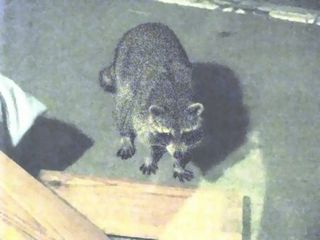How to Salvage Photos Gone Horribly Wrong
Not everybody has time to learn photography 101. Here’s how to make the best of bad images after the damage has been done, with software.
Working with the Unbearably Bad Photo–Fine Tuning
There’s still a lot of noise in this image, but most of it can be successfully removed. The detail that must be protected is in the raccoon and the background isn’t really relevant. So I selected the raccoon using PhotoImpact’s Lasso tool with the Smart Lasso option checked. This option is sometimes called a magnetic lasso in other photo editors. Once the raccoon was selected, I inverted the selection, so that everything except the raccoon would be selected. This enabled using a high setting in PhotoImpact’s Remove Noise filter, which removed noise in the entire image, except for the raccoon.
As a final step, I downsized the image to about 50% of its original size. Downsizing helps noise to naturally blend into the image (this same technique can be used to remove moiré patterns in scanned images).

The final image isn’t one I’d submit with a job application to work as a photographer, but it is suitable for use on a MySpace page. Although the final image still shows some flaws, the result is infinitely better than the original, almost completely black image.
Sign up to get the BEST of Tom's Guide direct to your inbox.
Get instant access to breaking news, the hottest reviews, great deals and helpful tips.
Current page: Working with the Unbearably Bad Photo–Fine Tuning
Prev Page Working with the Unbearably Bad Photo –Making Progress Next Page Some Final Thoughts-
superhighperf how about fixing the photo that was in the cover?Reply
http://media.bestofmicro.com/adjustment-saturation-tuning,0-4-178852-2.jpg
bait and switch article ?!?!?!?! -
As a professional VFX artist, I have to say that this article is a little on the juvenile side. Some of the "after" photos contain less information than the "before" photos. You never want to clip information in your photograph, and always want even exposure. Never underestimate a good matte for affecting only certain portions of your image. Furthermore, a good levels adjustment never hurt, and can always add some "punch" to your image.Reply
-
The article text provides a reasonable introduction to basic photo editing, but the "fixed" photos are perfect examples of what happens when a beginner goes way, way overboard. It's too bad because the miserable "after" photos significantly undermine the credibility of the article.Reply
-
mediv42 Why do people insist a bluer sky or greener trees make a better picture? Isn't the point of photography to capture what actually is, not whimsically change it to what you want it to be? Sure I understand if you underexposed the photo, or your white balance is off or whatever, but shouldn't the goal generally be what the subject actually looked like?Reply -
idisarmu This reminds me of the millions upon millions of teenage girls who see a picture of themselves and say, "Oh noes!!! ACNE!" *cries for hours and then suddenly has epiphany* "WAIT! I've GOT IT! I'll just crank up the brightness and make the picture black&white! THANK YOU COMPUTER!"Reply -
AARRGGHHH idisarmuThis reminds me of the millions upon millions of teenage girls who see a picture of themselves and say, "Oh noes!!! ACNE!" *cries for hours and then suddenly has epiphany* "WAIT! I've GOT IT! I'll just crank up the brightness and make the picture black&white! THANK YOU COMPUTER!"Reply
Black and White hides zits? That IS an epiphany.
I enjoyed the article.
